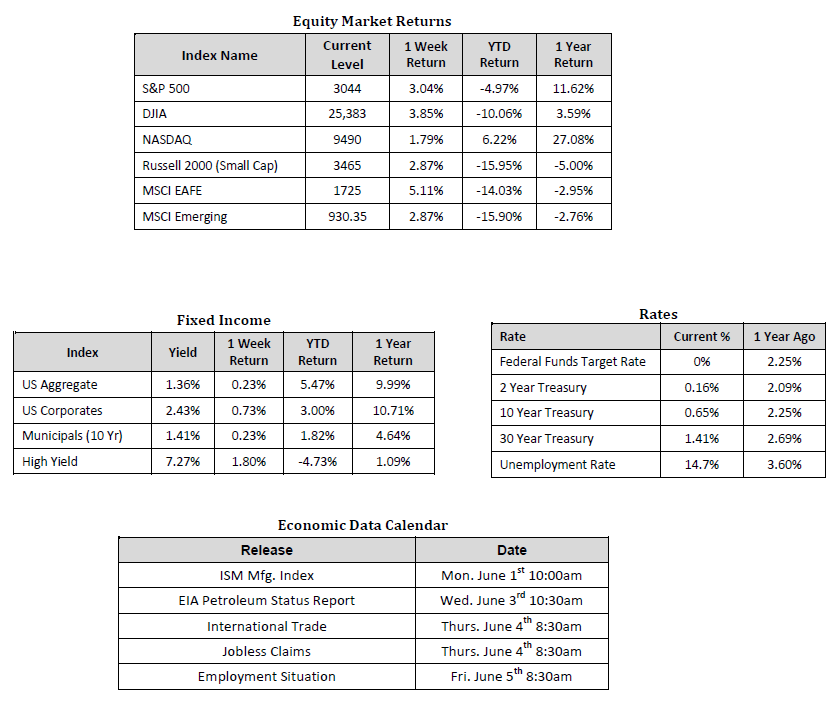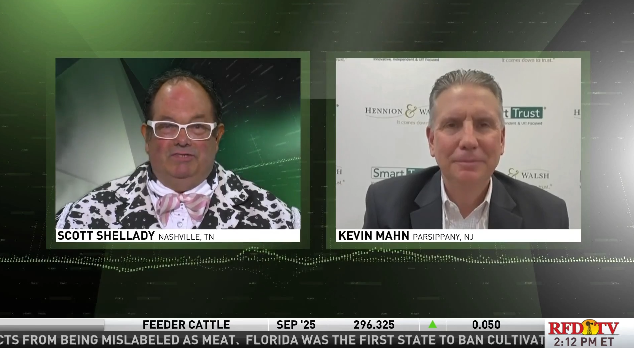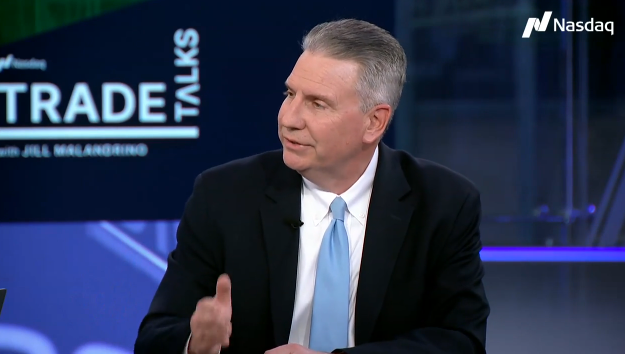
Last Week’s Markets in Review: COVID-19’s Impact on Dividends

Stocks cap off the week, and month of May, with gains. In the U.S., the S&P 500 Index rose to a level of 3,044, representing an increase of 3.04%, while the Russell Midcap Index moved 4.32% higher last week. Meanwhile, the Russell 2000 Index, a measure of the Nation’s smallest publicly traded firms, returned 2.87% over the week. On the international equities front, developed and emerging markets also advanced, returning 5.11% and 2.87%, respectively. Finally, the yield on the 10-year U.S. Treasury was relatively unchanged, finishing the week at 0.65%.
Throughout the week, encouraging news surrounding reopenings, vaccine developments, and the potential for additional stimulus appeared to lift investor’s spirits as markets moved higher during the holiday-shortened trading week. Then geopolitical concerns crept back into the picture, putting somewhat of a damper on sentiment later in the week. China is once again the center of attention over plans to implement new national security laws in Hong Kong, a proposal that was later approved on Thursday. We also received some encouraging economic news last week. For example, although another 2.1 million applied for unemployment, a drop in continuing claims suggests some unemployed workers are finding work. In addition, durable goods orders fell less than expected.
In this week’s update, we wanted to take an in-depth look at dividends and how the COVID-19 pandemic has impacted company dividend policies thus far. With the Federal Funds Target Rate set to remain near zero for the foreseeable future and traditional fixed-income yields at historically low levels, equity dividends are looking more and more attractive. What’s important for investors to remember is that dividends come with an added layer of risk as a company can cut or suspend dividends with no legal recourse, whereas a company cannot necessarily discontinue a bond payment without legal reasoning such as entering into default, a situation far more detrimental for a company’s outlook. The suspension risk for dividend payments for stocks is typically higher during slow growth and recessionary periods. However, the COVID-19 pandemic, and subsequent “lock-down” orders, shocked the economy at such a pace that companies were unable to prepare for such a quick and dramatic hit to cash flows.
According to J.P. Morgan as of May 26, 2020, 36 companies in the S&P 500 Index suspended their dividends, while 13 decreased payments since the onset of COVID-19. Suspensions and cuts typically send a strong negative signal to investors, so these decisions are made with careful consideration, and management will often do whatever it takes to “protect” the dividend. These cuts and suspensions thus show the amount of stress COVID-19 has placed on certain companies and industries. Energy, leisure products, and travel are some examples of the industries that have felt the pain more than others thus far. In addition, we may likely see additional potential cuts or suspensions in the future. Many payments scheduled in Q1, or even early Q2, of 2020 were already declared, leaving companies hard-pressed to reverse these decisions. The second quarter of 2020 is likely to be the worst of the year from an economic activity standpoint, so more cuts and suspensions seem probable from our standpoint.

Source: J.P. Morgan Quantitative and Derivatives Strategy, 2020.
So what does this mean for investors? While some investors simply review a stock’s current yield, we believe that the sustainability of dividends is often as important as the current yield to income-oriented investors. For that reason, it’s important to take a more in-depth look at a company’s financials and forecasts. Higher quality companies with solid balance sheet fundamentals and strong histories of earnings and revenue growth may be more likely to maintain or even increase dividend payments in different market environments.
In times of economic stress and uncertainty, portfolio managers and investment strategists often stress the importance of investing in companies with solid balance sheets to help weather economic downturns. Companies that not only pay dividends but have a history of growing their dividends show both financial strength and management’s confidence in continuing to increase their respective dividends. In fact, research studies have shown that above-average dividend increases over time have historically outperformed companies that don’t grow, or don’t pay, dividends.
Moving forward, we expect dividends to play an even more important role in the total return equation in the months and years ahead. Therefore, investors may want to consider such dividend-paying stocks to help boost total return potential.
As always, we encourage investors to stay disciplined and work with experienced financial professionals to help manage their portfolios through various market cycles within an appropriately diversified framework that is consistent with their objectives, time-frame, and tolerance for risk. We recognize that these are very troubling and uncertain times and we want you to know that we are always here for you to help in any way that we can. Stay safe and stay well.
Sources for data in tables: Equity Market and Fixed Income returns are from JP Morgan as of 5/29/20. Rates and Economic Calendar Data from Bloomberg as of 5/29/20. International developed markets measured by the MSCI EAFE Index, emerging markets measured by the MSCI EM Index, U.S. Large Cap defined by the S&P 500. Sector performance is measured using GICS methodology.
Important Information and Disclaimers
Disclosures: Past performance does not guarantee future results. We have taken this information from sources that we believe to be reliable and accurate. Hennion and Walsh cannot guarantee the accuracy of said information and cannot be held liable. You cannot invest directly in an index. Diversification can help mitigate the risk and volatility in your portfolio but does not ensure a profit or guarantee against loss. Hennion & Walsh is the sponsor of SmartTrust® Unit Investment Trusts (UITs). For more information on SmartTrust® UITs, please visit www.smarttrustuit.com. The overview above is for informational purposes and is not an offer to sell or a solicitation of an offer to buy any SmartTrust® UITs. Investors should consider the Trust’s investment objective, risks, charges and expenses carefully before investing. The prospectus contains this and other information relevant to an investment in the Trust and investors should read the prospectus carefully before they invest.
Investing in foreign securities presents certain risks not associated with domestic investments, such as currency fluctuation, political and economic instability, and different accounting standards. This may result in greater share price volatility. These risks are heightened in emerging markets.
There are special risks associated with an investment in real estate, including credit risk, interest rate fluctuations and the impact of varied economic conditions. Distributions from REIT investments are taxed at the owner’s tax bracket.
The prices of small company and mid cap stocks are generally more volatile than large company stocks. They often involve higher risks because smaller companies may lack the management expertise, financial resources, product diversification and competitive strengths to endure adverse economic conditions.
Investing in commodities is not suitable for all investors. Exposure to the commodities markets may subject an investment to greater share price volatility than an investment in traditional equity or debt securities. Investments in commodities may be affected by changes in overall market movements, commodity index volatility, changes in interest rates or factors affecting a particular industry or commodity.
Products that invest in commodities may employ more complex strategies which may expose investors to additional risks.
Investing in fixed income securities involves certain risks such as market risk if sold prior to maturity and credit risk especially if investing in high yield bonds, which have lower ratings and are subject to greater volatility. All fixed income investments may be worth less than original cost upon redemption or maturity. Bond Prices fluctuate inversely to changes in interest rates. Therefore, a general rise in interest rates can result in the decline of the value of your investment.
Definitions
MSCI- EAFE: The Morgan Stanley Capital International Europe, Australasia and Far East Index, a free float-adjusted market capitalization index that is designed to measure developed-market equity performance, excluding the United States and Canada.
MSCI-Emerging Markets: The Morgan Stanley Capital International Emerging Market Index, is a free float-adjusted market capitalization index that is designed to measure the performance of global emerging markets of about 25 emerging economies.
Russell 3000: The Russell 3000 measures the performance of the 3000 largest US companies based on total market capitalization and represents about 98% of the investible US Equity market.
ML BOFA US Corp Mstr [Merill Lynch US Corporate Master]: The Merrill Lynch Corporate Master Market Index is a statistical composite tracking the performance of the entire US corporate bond market over time.
ML Muni Master [Merill Lynch US Corporate Master]: The Merrill Lynch Municipal Bond Master Index is a broad measure of the municipal fixed income market.
Investors cannot directly purchase any index.
LIBOR, London Interbank Offered Rate, is the rate of interest at which banks offer to lend money to one another in the wholesale money markets in London.
The Dow Jones Industrial Average is an unweighted index of 30 “blue-chip” industrial U.S. stocks.
The S&P Midcap 400 Index is a capitalization-weighted index measuring the performance of the mid-range sector of the U.S. stock market, and represents approximately 7% of the total market value of U.S. equities. Companies in the Index fall between S&P 500 Index and the S&P SmallCap 600 Index in size: between $1-4 billion.
DJ Equity REIT Index represents all publicly traded real estate investment trusts in the Dow Jones U.S. stock universe classified as Equity REITs according to the S&P Dow Jones Indices REIT Industry Classification Hierarchy. These companies are REITs that primarily own and operate income-producing real estate.



